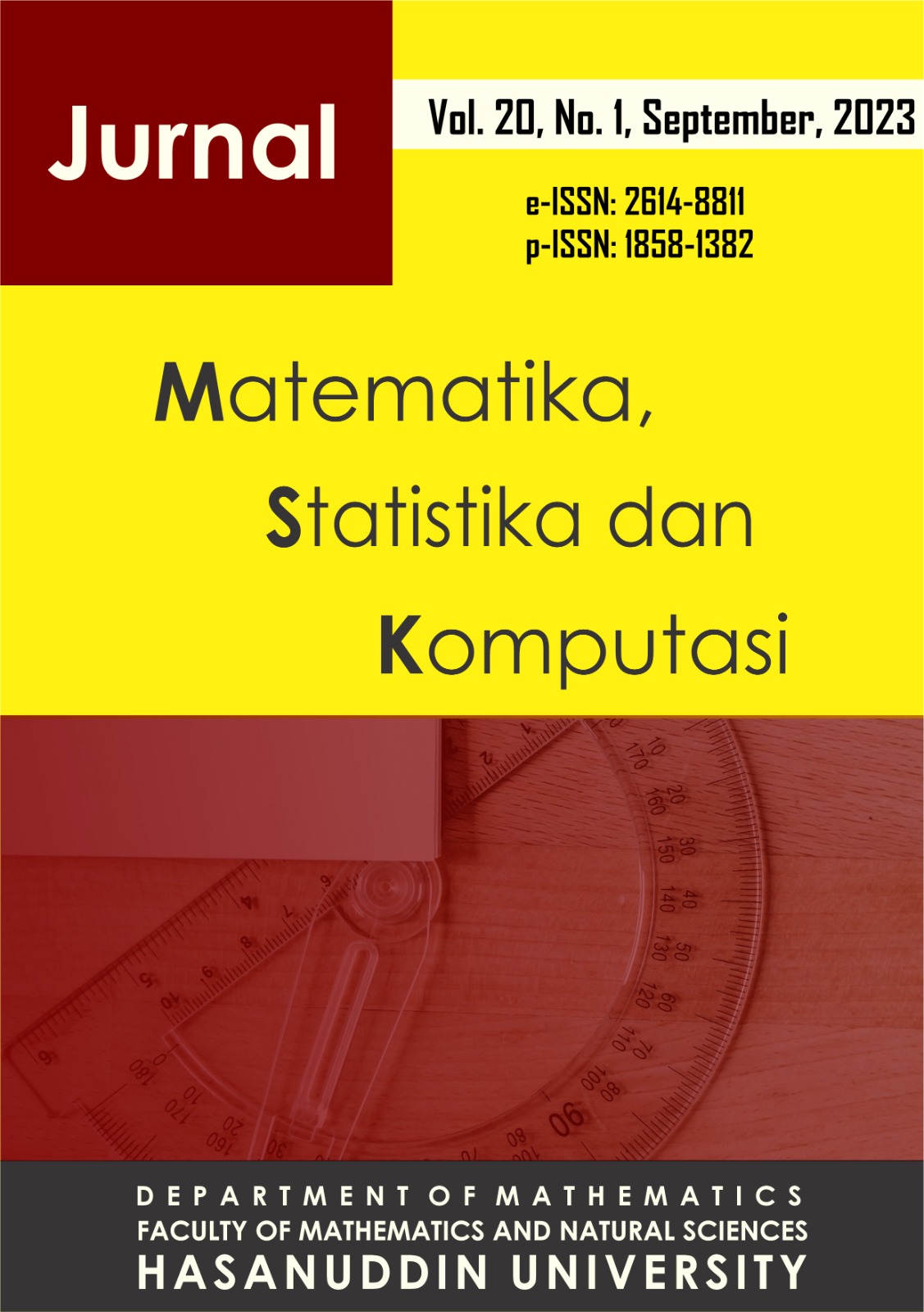Stock Portfolio Optimization Using Mean-Variance and Mean Absolute Deviation Model Based On K-Medoids Clustering by Dynamic Time Warping
DOI:
https://doi.org/10.20956/j.v20i1.27755Keywords:
Dynamic Time Warping, Expected Tail Loss, K-Medoids Clustering, Mean-Variance,, Mean Absolute Deviation, Monte CarloAbstract
The tendency of investors to choose investments with maximum return and minimal risk causes the need for diversification in a portfolio to form an optimal portfolio. A lot of research on stock portfolio optimization has been conducted extensively, but not many have tried to apply machine learning concepts such as clustering analysis to accelerate the establishment of a model that can have a positive effect on the time and cost efficiency of portfolio management. However, clustering is only limited to determining the optimal stock candidate, so it is necessary to add another optimization model to calculate the portfolio weight. Based on these problems, this study carried out portfolio optimization using Mean-Variance (MV) and Mean Absolute Deviation (MAD) model based on K-Medoids Clustering by Dynamic Time Warping approach using Monte Carlo-Expected Tail Loss for risk analysis. Based on the analysis results, the MAD portfolio is more optimal than the MV portfolio by the MAD portfolio consists of five stocks, namely BMRI shares with a weight of 0.06243, UNTR shares of 0.08658, BBRI shares of 0.10285, BBCA of 0.53623, and KLBF shares of 0.21191 are the best optimal portfolios. The optimal portfolio of the MAD model has a rate of return of 87.836% in May 2017 - December 2022 with a portfolio performance of 0.03704, while the resulting risk level based on Carlo-Expected Tail Loss is 2.2416%.
References
Al Fatah, R. S., 2022. Pengelompokan Emiten Saham Consumer non Cyclical Menggunakan Jarak Euclidean dan Dynamic Time Warping.
Alijoyo, A., Wijaya, B., & Jacob, I. 2019. Monte Carlo Simulation. Center for Risk Management & Sustainability.
Bower, B., & Wentz, P., 2005. Portfolio optimization: MAD vs. Markowitz. Rose-Hulman Undergraduate Mathematics Journal, Vol. 6(2005), No. 2, 3.
Chalabi, Y., Scott, D. J., & Wuertz, D., 2012. Flexible distribution modeling with the generalized lambda distribution.
Chen, W., Zhang, H., Mehlawat, M. K., & Jia, L., 2021. Mean–variance portfolio optimization using machine learning-based stock price prediction. Applied Soft Computing, Vol. 100, 106943.
Giorgino, T., 2009. Computing and visualizing dynamic time warping alignments in R: the dtw package. Journal of statistical Software, Vol. 31, No. 31, 1-24.
Gubu, L., Rosadi, D., & Abdurakhman, 2019. Classical portfolio selection with cluster analysis: Comparison between hierarchical complete linkage and ward algorithm. AIP Conference Proceedings, Vol. 2192, No. 1, p. 090004.
Gubu, L., Rosadi, D., & Abdurakhman, A., 2021. Pembentukan Portofolio Saham Menggunakan Klastering Time Series K-Medoid dengan Ukuran Jarak Dynamic Time Warping. Jurnal Aplikasi Statistika & Komputasi Statistik, Vol. 13, No. 2, 35-46.
Herlinawati, A., Hendrawati, T., & Bachrudin, A., 2021. Pengelompokan Wilayah di Jawa Barat Berdasarkan Data Curah Hujan Menggunakan Jarak Dynamic Time Warping. E-Journal BIAStatistics Departemen Statistika FMIPA Universitas Padjadjaran, Vol. 15, No. 2, 1.
Ivanova, M., & Dospatliev, L., 2017. Application of Markowitz portfolio optimization on Bulgarian stock market from 2013 to 2016. Journal of Pure and Applied Mathematics, Vol. 117, No. 2, 291-307.
Kasenbacher, G., Lee, J., & Euchukanonchai, K., 2017. Mean-variance vs. mean-absolute deviation: A performance comparison of portfolio optimization models. University of British Columbia.
Kumar, U., Legendre, C. P., Lee, J. C., Zhao, L., & Chao, B. F., 2022. On analyzing GNSS displacement field variability of Taiwan: Hierarchical Agglomerative Clustering based on Dynamic Time Warping technique. Computers & Geosciences, Vol. 169, 105243.
Lam, W. S., Lam, W. H., & Jaaman, S. H., 2021. Portfolio optimization with a mean–absolute deviation–entropy multi-objective model. Entropy, Vol. 23, No. 10, 1266.
Markowitz, H.,1952. Portfolio Selection in The Journal of Finance, Vol. 7.
Prihatiningsih, D. R., Di Asih, I. M., & Rahmawati, R., 2020. Value at Risk (VaR) dan Conditional Value at Risk (CVaR) Dalam Pembentukan Portofolio Bivariat Menggunakan Copula Gumbel. Jurnal Gaussian, Vol. 9, No. 3, 326-335.
Putri, M. M., & Fithriasari, K., 2015. Pengelompokan Kabupaten/Kota di Jawa Timur Berdasarkan Indikator Kesehatan Masyarakat Menggunakan Metode Kohonen SOM dan K-Means. Jurnal Sains dan Seni ITS, Vol. 4, No. 1, D13-D18.
Senin P., 2008. Dynamic Time Warping Algorithm Review. Honolulu (USA): University of Hawaii.
Sureja, N., Chawda, B., & Vasant, A., 2022. An improved K-medoids clustering approach based on the crow search algorithm. Journal of Computational Mathematics and Data Science, Vol. 3, 100034.
Wang, W., & Lu, Y., 2018. Analysis of the mean absolute error (MAE) and the root mean square error (RMSE) in assessing rounding model. IOP conference series: materials science and engineering, Vol. 324, No. 1, p.012049).
Downloads
Published
How to Cite
Issue
Section
License
Copyright (c) 2023 Author and publisher

This work is licensed under a Creative Commons Attribution 4.0 International License.

This work is licensed under a Creative Commons Attribution 4.0 International License.
Jurnal Matematika, Statistika dan Komputasi is an Open Access journal, all articles are distributed under the terms of the Creative Commons Attribution License, allowing third parties to copy and redistribute the material in any medium or format, transform, and build upon the material, provided the original work is properly cited and states its license. This license allows authors and readers to use all articles, data sets, graphics and appendices in data mining applications, search engines, web sites, blogs and other platforms by providing appropriate reference.







